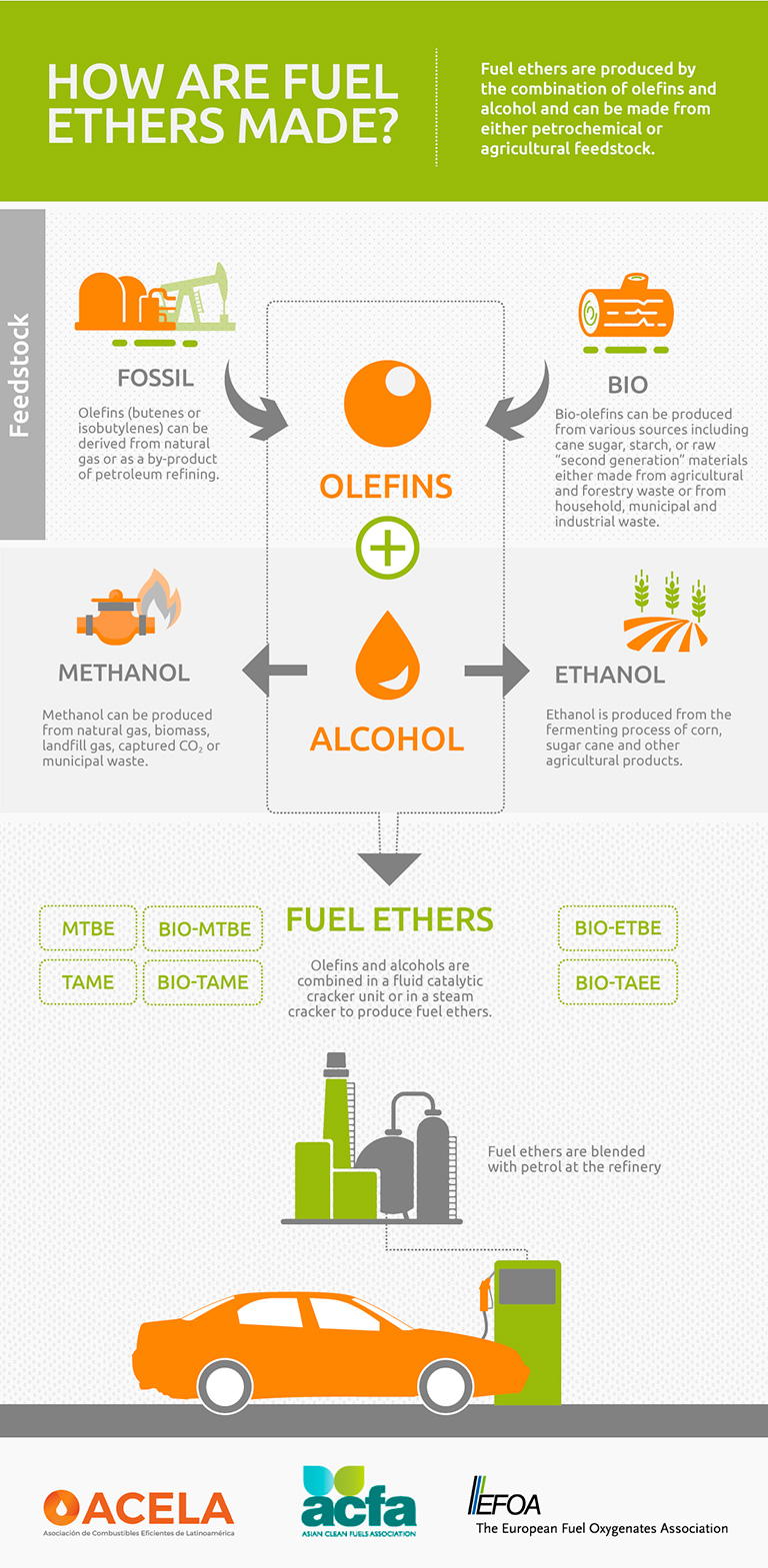Fuel ethers are a great way of reducing the impact that transport has on our environment.
When used to formulate petrol, fuel ethers improve the quality of the air we breathe by reducing vehicle emissions and enabling cleaner-burning petrol, while also increasing engine efficiency and performance.
It might sound impossible but fuel ethers can do all of this and more, without requiring wholesale changes to our transport systems and infrastructure – all while meeting the highest regulatory standards across the globe.
Fuel ethers, which are sometimes referred to as oxygenates, include the ethers known as:
- Methyl tert-butyl ether (MTBE)
- Ethyl tert-butyl ether (ETBE)
- Tert-amyl methyl ether (TAME)
- Tert-amyl ethyl ether (TAEE)
These ethers are a blending component of petrol. Petrol consists of many different hydrocarbons, which are refined from crude oil and then blended with other elements to create the fuels we put into our engines.
How are fuel ethers made?
Fuel ethers can be produced through a variety of methods, including from traditional petrochemical sources, fermented agricultural products, natural gas derivations and biomass. The building blocks for fuel ethers are the hydrocarbons isobutylene or isoamylenes reacted with methanol or ethanol.
Fuel ethers, in their role as petrol-blending components, allow for the formation of higher-performing and cleaner-burning fuel
Ethanol, which is produced by fermenting wheat, sugar beet and other agricultural products, is the feedstock for ETBE or TAEE. Methanol, produced primarily from biomass or natural gas, is a feedstock used to make MTBE or TAME. Isobutylene, which is the other feedstock used in both MTBE and ETBE production, is also derived from natural gas, or as a petroleum refinery co-product. Isoamylenes, which are used to produce TAME or TAEE, are the co-products of petroleum refining.

What do fuel ethers do?
In their role as blending components for petrol, they allow for the formulation of higher performing and cleaner-burning fuels. They achieve this by both raising the octane and oxygen levels of petrol, and contributing low blending volatility.
The higher its octane number, the greater the compression petrol can be put under without prematurely igniting. Higher-octane fuels can therefore run higher compression engines as they won’t ignite early, allowing for greater engine power. This also prevents damaging engine ‘knocking’, cutting the wear on engine components, reducing the need for maintenance and extending engine life.
Higher-octane fuels can run higher compression engines as they won’t ignite early, allowing for greater engine power
High-octane fuels allow vehicles to travel further on the same tank of petrol, saving money on fuel costs. They also help enable the use of smaller and more efficient engines, including getting the best cost efficiency out of hybrid engines.
Hybrid vehicles, which combine conventional internal combustion with electric propulsion, see reduced emissions from their thermal component when powered by higher-octane petrol containing fuel ethers. This is just one form of technology complemented by fuel ethers, with direct injection and turbocharging also seeing benefits. This adaptability means car manufacturers can get more out of their products in terms of reliability and performance.

How do fuel ethers improve the air we breathe?
When petrol is formulated with fuel ethers, they raise its oxygen content, leading to more complete combustion. This means that all fuel is burned inside the engine rather than expelled through the exhaust system into our air, allowing for cleaner-running engines.
MOVES-Mexico is an adapted version of the US Environment Protection Agency’s MOVES2014a model that estimates the vehicle emissions of different toxic substances. The following table compares various toxic emissions from different oxygenated gasoline blends with a non-oxygenated base fuel blend.

When compared to the non-oxygenated base fuel, the fuel blended with 11.9% volume MTBE reduces a variety of toxic emissions from vehicles, in particular:
MTBE REDUCES…
- Carbon monoxide by 14%
- Toxics by 23%
- Particulate matter (PM) by 1%
- Benzene by 37%
The MTBE fuel compares favourably with the fuel containing 10% volume ethanol (E10), which actually increases certain toxic vehicle emissions when compared to a non-oxygenated fuel blend, in particular:
E10 INCREASES…
- Toxics by 6%
- Volatile organic compounds (VOCs) by 17%
- PM2.5 by 29%

How do fuel ethers boost fuel security?
One of fuel ethers’ unique qualities is that they can be added to our existing vehicle and infrastructure systems with no need for complex or expensive adaptation measures. This means they can run in older models of cars that are more commonly used in developing countries, increasing their ability to be adopted across the world.
The addition of fuel ethers could increase fuel supply by as much as 8-15%
Fuel ethers also increase the amount of petrol that can be processed from a single barrel of crude oil. The addition of fuel ethers could increase fuel supply by as much as 8-15%, and could easily be applied in older, less complex refinery systems. This flexibility of application, combined with the diversity of sources for producing them, means that fuel security is positively impacted by the use of fuel ethers. With the need for more efficient use of existing natural resources, fuel ethers can play a vital role in improving the efficiency of our transport systems.
Their many unique qualities mean that fuel ethers are the oxygenate of choice when it comes to improving petrol quality in our vehicles. Their ability to reduce emissions and improve air and fuel quality, as well as their compatibility with existing infrastructure and vehicles, mean fuel ethers are the best way to ensure we have the cleanest, most efficient combustion engine systems possible.
